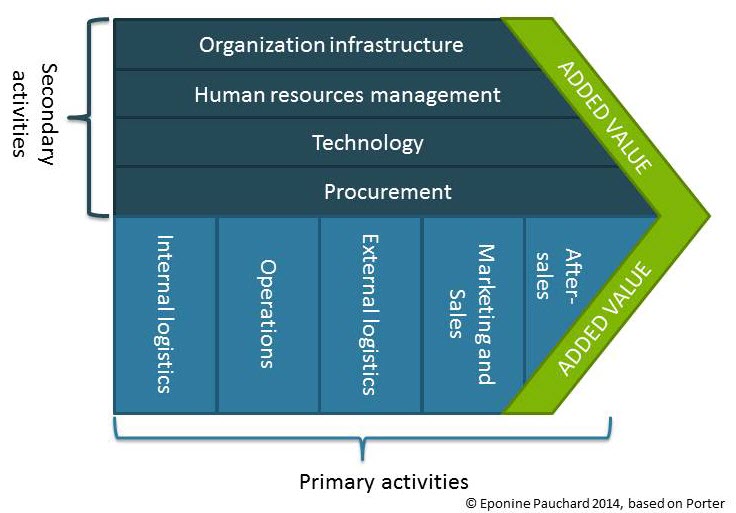The value chain contains the core activities of the organization. You need to identify these activities at different levels to fully understand what brings value to your customer. This is the best way to ensure the consistency and success of your organization.
Whatever your role, you need to understand your place in your organization’s value chain. But do you know what it is, and how to identify it? Without it, the organization does not exist. Let’s take a few moments to identify and position ourselves.

What is the value chain?
The value chain of an organization includes all the steps required to transform inputs into outputs. In the manufacturing sector, it is very easy to identify: just look at the steps involved in transforming the products delivered (inputs) into products that leave the production or assembly line to be sold (outputs).
These are all activities that add value to the input so that it becomes an output.
If I take the example of a vineyard, it is all the steps to transform the vine into wine, including the maintenance of the vines, harvesting, vinification, bottling and, depending on the vineyard, distribution.
In the service sector, the value chain is more difficult to identify because it is not material. Let’s take the example of a hairdresser: his value chain starts at the appointment booking. It ends when the client leaves the salon after paying. All the steps in between, such as waiting or shampooing, are part of it. Value is more than just a haircut.
If your service is virtual, it gets even more complicated… An accounting or tax software’s input is data, entered by hand or imported from a file. And its output is also data. But it has been transformed. Various calculations, groupings or transfers have added value to the “raw” data captured.
How to identify your value chain
You can formalize the value chain with several methods. My favorite, because I find it the most effective, is the Gemba. Walking the process, whether real or virtual, ensures the completeness of the analysis. You can also use the diagram below, which shows the major value areas, as formalized by Michael Porter, professor of strategy at Harvard.

For each of these areas, you can ask yourself about your activities and identify what brings value, directly or indirectly, to your customers.
This is the first step, which concerns your entire organization. Most organizations have a single value chain. Although it is rarer, some groups have several. For example, in the financial industry, there may be a banking component and an insurance component. In this case, I advise you to consider only the one in which you play a role.
The second step is to identify your contributions in this chain. If you work in purchasing at a winery, you are primarily involved in the first step: purchasing agricultural products and services. If you are responsible for IT, you contribute to the whole chain. You will have more work to understand the value you’re adding at each step, because there are more steps.
What’s next?
Once you know the steps you’re working on, you have to ask yourself the question, “Does the customer want to pay for this?” The answer is not always obvious. Customers always want to pay as little as possible. For example, in a hair salon, the customer is willing to pay for comfortable chairs. On the other hand, the customer may feel that a coffee does not provide value. It all depends on your positioning.
Put yourself in the customer’s shoes and then determine what should (and should not) be included in the value you deliver. You go down one level and go back to the value chain to detail your operations and their contribution.
You can then optimize your operations: what brings value to the customer? What does he buy? It’s also useful for ensuring that the value proposition you offer is competitive in your market.
How about taking a step back?
Finally, you can look at a higher level, how your organization fits into a more global value chain. For example, in the case of the vineyard, it is in the middle of a much larger supply chain. From producers of agricultural products and services, to supermarkets, wholesalers and transporters, you are in the middle of the chain. It is a different positioning from an organization at the beginning or end of the chain. If you are the first one, you impact all the others behind. Your customer is not only the one to whom you sell your services, but also the one at the end of the chain.
It can be a bit dizzying. You don’t have to meet the needs of all these customers. However, by understanding your position, and how value is generated, you can make better decisions. If you manufacture a product, your distributor is most interested in the availability of your products. But for the final customer, quality remains the key factor. So you need to balance the needs of the different levels of customers.
On the other hand, if, like the hairdresser, you are alone in your supply chain, it is easier. You have more levers to organize your operations to deliver maximum value to your customers.
